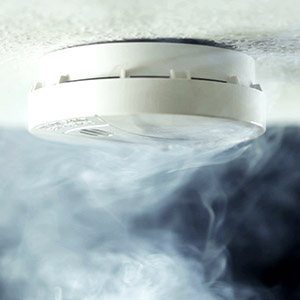
Installing smoke detectors in your home or workplace is essential – they provide early warning, giving you, your family and your workmates, the best chance of escape in the event of a fire.
In most states of Australia, it’s compulsory to install working smoke alarms – and the statistics show that they work. According to the Metropolitan Fire Brigade you are 57% more likely to suffer property loss and damage, 26% more likely to suffer serious injuries, and four times more likely to die, if you are caught in a fire in a building that does not have a working smoke alarm.
So what type of smoke alarm is best? There are two main types of smoke alarms to choose from: ionisation and photoelectric. Each work differently, and knowing which smoke alarm you need, and where to install it, can be confusing. So before you install one, it’s important to understand how they work.
What’s the Difference Between Ionisation and Photoelectric Smoke Alarms?
We’ll start with ionisation – these smoke alarms can quickly detect invisible smoke produced by fast flaming fires. They are responsive to fires such as cooking, paper or flammable liquid fires. They will alarm when the ion flow in the detection chamber is affected by smoke particles.
Photoelectric smoke alarms use optical detection and are triggered when smoke particles enter the light path in the detection chamber. They are most responsive to slow, smouldering fires, such as those that can occur in the home while you sleep.
Which Smoke Alarm Should I Choose?
Fires can start in many different ways, and are often unpredictable, so installing both ionisation and photoelectric smoke alarms is the best choice for your protection. It’s also important to strategically locate them within the home, to maximise their effectiveness.
Because many residential fires begin by smouldering, photoelectric smoke alarms provide the best overall protection. So if you decide to only install one type of smoke alarm, we recommend you choose photoelectric.
Where Should I Put My Smoke Alarms?
In your home, smoke alarms should be placed between each bedroom area and the rest of the house, and if you have a two-storey home, they must be located on all levels. Plus, if anyone sleeps with their door shut, you should install a smoke alarm inside the bedroom too.
Photoelectric smoke alarms are ideal for hallways and living areas, while ionisation smoke alarms are good for bedrooms. It’s also worth noting that ionisation smoke alarms can be set off easily by your cooking, so it’s best to avoid installing them close to the kitchen.
And Finally… Make Sure They Work
Once you’ve installed your smoke alarms, it’s important to keep them working. Smoke alarms should be tested monthly, and you can do this by pressing the test button with a broom handle. If your smoke alarm is beeping, it’s likely it needs a new battery – if it beeps after a new battery is installed, it should be replaced. You should make a habit of changing all 9V batteries in your smoke alarms at least yearly. All smoke alarms have a lifespan and should be replaced after 10 years – the date of manufacture can be found on the alarm.
Smoke Detector Tester
Use the Lifesaver Smoke Detector Tester to test all of your alarms every 6 months.
So choose the right smoke alarm and take the time to maintain it – because working smoke alarms do save lives.


